
The order Insectivora is a now-abandoned biological grouping within the class of mammals. Some species have now been moved out, leaving the remaining ones in the order Eulipotyphla, within the larger clade Laurasiatheria, which makes up one of the most basic clades of placental mammals.

Shrews are small mole-like mammals classified in the order Eulipotyphla. True shrews are not to be confused with treeshrews, otter shrews, elephant shrews, or the West Indies shrews, which belong to different families or orders.
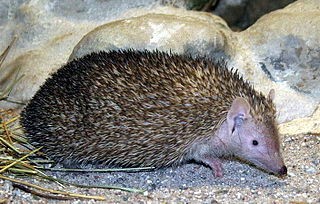
The order Afrosoricida contains the golden moles of Southern Africa, the otter shrews of equatorial Africa and the tenrecs of Madagascar. These three families of small mammals have traditionally been considered to be a part of the order Insectivora, and were later included in Lipotyphla after Insectivora was abandoned as a wastebasket taxon, before Lipotyphla was also found to be polyphyletic.
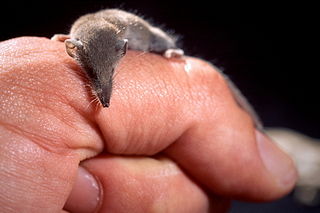
The Etruscan shrew, also known as the Etruscan pygmy shrew or the white-toothed pygmy shrew, is the smallest known extant mammal by mass, weighing only about 1.8 g (0.063 oz) on average.
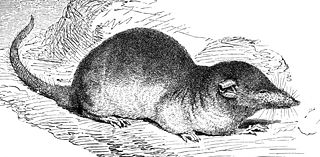
The white-toothed shrews or Crocidurinae are one of three subfamilies of the shrew family Soricidae.
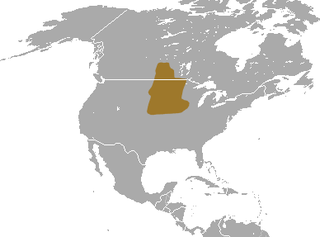
The prairie shrew is a small shrew found in the Canadian prairies and midwestern United States. At one time, this species was considered to be a subspecies of the similar cinereus shrew, S. cinereus.

The Eurasian water shrew, known in the United Kingdom as the water shrew, is a relatively large shrew, up to 10 cm (4 in) long, with a tail up to three-quarters as long again. It has short, dark fur, often with a few white tufts, a white belly, and a few stiff hairs around the feet and tail. It lives close to fresh water, hunting aquatic prey in the water and nearby. Its fur traps bubbles of air in the water which greatly aids its buoyancy, but requires it to anchor itself to remain underwater for more than the briefest of dives.

The lesser white-toothed shrew is a tiny shrew with a widespread distribution in Africa, Asia and Europe. Its preferred habitat is scrub and gardens and it feeds on insects, arachnids, worms, gastropods, newts and small rodents, though its diet usually varies according to the biotope where it lives. The closely related Asian lesser white-toothed shrew was once included in this species, but is now considered to be a separate species.

The Asian house shrew is a shrew species native to South and Southeast Asia that has been listed as Least Concern on the IUCN Red List since 2008 because of its large population and wide distribution. It has been introduced in several West Asian and East African countries. It is considered an invasive species and implicated in the demise of several island lizard species.

The black shrew is a white-toothed shrew only known from Mount Kinabalu in the Malaysian state of Sabah on the island of Borneo. It is listed as a critically endangered species due to habitat loss and a restricted range. It is the smallest shrew of its kind and lives in parts of middle Asia.
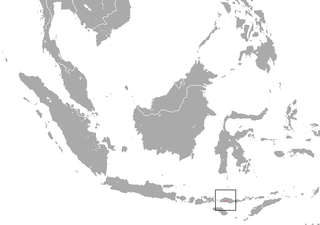
The Flores shrew is a white-toothed shrew found only on Flores Island, Indonesia. It is listed as a critically endangered species due to habitat loss and a restricted range.

The slender shrew is a species of shrew. An adult slender shrew has a weight of 1.5-5.3 grams and a body length of 4.7-6.0 centimeters, with a tail of 4-5 centimeters; this makes it one of the smaller shrews found in its range. It is distributed across northeastern North Korea, Hokkaidō, and the Russian Far East including the Kuril Islands.
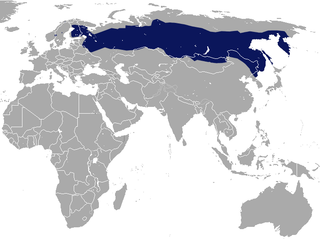
The taiga shrew, also known as the even-toothed shrew can achieve a body length of about 67 millimeters, with a tail of about 43 millimeters. This shrew is very similar to the long-clawed shrew. This species inhabits forested mountain valleys, and is found across northern Eurasia. It ranges from the Baltic Sea area through the Lake Baikal region of Siberia into the Russian Far East and along the Baekdudaegan mountains of the Korean Peninsula.

Suncus is a genus of shrews in the family Soricidae.

Soricomorpha is a formerly used taxon within the class of mammals. In the past it formed a significant group within the former order Insectivora. However, Insectivora was shown to be polyphyletic and various new orders were split off from it, including Afrosoricida, Macroscelidea, and Erinaceomorpha, with the four remaining extant and recent families of Soricomorpha shown here then being treated as a separate order. Insectivora was left empty and disbanded.
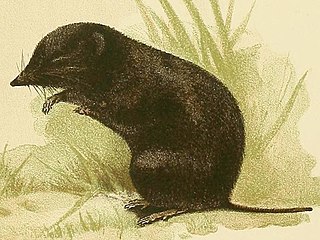
Myosorex is a mammal genus in the Soricidae (shrew) family. The genus, collectively referred to as the mouse shrews, contains these species:
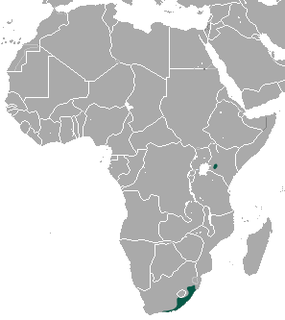
The least dwarf shrew is a species of mammal in the family Soricidae. It is found in Cameroon, Central African Republic, Democratic Republic of the Congo, Kenya, Nigeria, South Africa, Eswatini, Tanzania, and Uganda. Its natural habitats are subtropical or tropical moist lowland forest, subtropical or tropical moist montane forest, temperate grassland, subtropical or tropical dry lowland grassland, subtropical or tropical high-altitude grassland, and arable land.

The greater dwarf shrew is a species of mammal in the family Soricidae. It is found in Angola, Botswana, Democratic Republic of the Congo, Kenya, Malawi, Namibia, Tanzania, Zambia, and Zimbabwe. Its natural habitats are subtropical or tropical dry forests and dry savanna. It is present in several protected areas, including the Kruger National Park. The main threat to shrews is the loss or degradation of moist, productive areas such as wetlands and rank grasslands within suitable habitat.
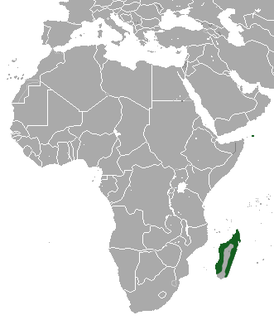
The Madagascan pygmy shrew is a species of mammal in the family Soricidae. It is the only known Malagasy shrew.

The Taiwanese mole shrew is one of four species of red-toothed shrews in the genus Anourosorex. This species is endemic to Taiwan.



















